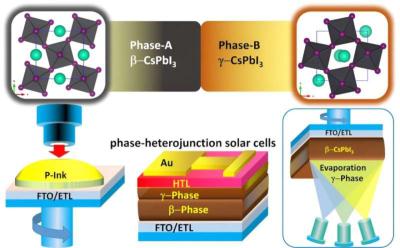Researchers from Chonnam National University, Chinese Academy of Sciences, Indian Institute of Science (IISc) and Pennsylvania State University have introduced an alternative solar cell design fully based on inorganic perovskites. Their solar cells could be easier to fabricate on a large-scale, while also achieving promising power conversion efficiencies (PCEs).
The key objective of the recent work was to create new solar cells fully based on inorganic perovskites using a developed method that could be easy to up-scale. Ultimately, they fabricated their solar cells using hot-air and thermal evaporation deposition techniques that work at ambient conditions without requiring polar solvents (i.e., liquids containing both positive and negative charges).
The team proposed and developed dimethylammonium iodide-assisted β−CsPbI3 and guanidinium iodide-assisted γ−CsPbI3 all-inorganic phase-heterojunction solar cells (PHSs) by integrating hot-air and triple-source thermal evaporation deposition techniques, respectively. Incorporating a (Zn(C6F5)2) molecular additive and dopant-free hole transport layer produced a 21.59% power conversion efficiency (PCE).
The laboratory-to-module scale showed 18.43% PCE with an 18.08 cm2 active area. The scientists demonstrated that this additive-assisted β−γ-based PHS structure exhibited >200 hours of stable performance under maximum power tracking under one sun illumination.
This work could pave the way towards dual deposition techniques for PHS with important consequences not only for all inorganic but also for other halide perovskite compositions.




